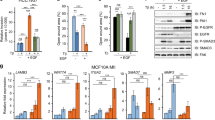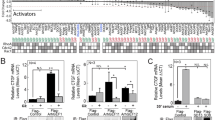Abstract
The oncogene Tpr-Met is a constitutively active form of the hepatocyte growth factor/scatter factor (HGF/SF) receptor Met. It comprises the intracellular moiety of Met linked to the dimerization domain of the nuclear envelope protein Tpr, thus functioning as a constitutively activated Met. HGF/SF is responsible for various biological processes including angiogenesis and wound healing, in which secreted serine protease urokinase-type plasminogen activator (uPA) is implicated. The action of HGF/SF on cells is mediated by the autophosphorylation of Met on two carboxyterminal tyrosine residues, Y1349VHVNATVY1356VNV. The two tyrosine residues provide docking sites for various effector molecules, suggesting that multiple signaling pathways are activated to exert biological effects of HGF/SF [Ponzetto et al., Cell (1994) 77: 261]. We found that Tpr-Met efficiently activates the uPA gene via a SOS/Ras/extracellular signal regulated kinase (ERK)-dependent signaling pathway. Mutation of Y1356, which abrogates GRB2 binding, reduced the induction to half of the control level, while mutation of Y1349 showed little effect on uPA induction, suggesting an important but partly replaceable role for GRB2 in Met-dependent uPA gene induction. Mutation of both Y1349VHV and Y1356VNV into optimal PI 3-kinase sites resulted in a residual induction of about one quarter of the control level, suggesting a potential role for PI 3-kinase. Dose-response analysis of the Tpr-Met showed a biphasic curve. These results suggest that the interplay among different signaling molecules on the receptor is important for full induction of the pathway leading to the activation of the uPA gene.
This is a preview of subscription content, access via your institution
Access options
Subscribe to this journal
Receive 50 print issues and online access
$259.00 per year
only $5.18 per issue
Buy this article
- Purchase on Springer Link
- Instant access to full article PDF
Prices may be subject to local taxes which are calculated during checkout
Similar content being viewed by others
Author information
Authors and Affiliations
Rights and permissions
About this article
Cite this article
Besser, D., Bardelli, A., Didichenko, S. et al. Regulation of the urokinase-type plasminogen activator gene by the oncogene Tpr-Met involves GRB2. Oncogene 14, 705–711 (1997). https://doi.org/10.1038/sj.onc.1200879
Received:
Revised:
Accepted:
Issue Date:
DOI: https://doi.org/10.1038/sj.onc.1200879
Keywords
This article is cited by
-
Therapeutic angiogenesis induced by human hepatocyte growth factor gene in rat and rabbit hindlimb ischemia models: preclinical study for treatment of peripheral arterial disease
Gene Therapy (2001)
-
Concomitant activation of pathways downstream of Grb2 and PI 3-kinase is required for MET-mediated metastasis
Oncogene (1999)
-
Opposing BMP and EGF signalling pathways converge on the TGF-β family mediator Smad1
Nature (1997)



